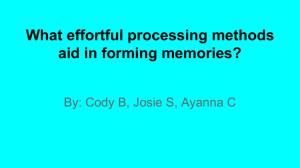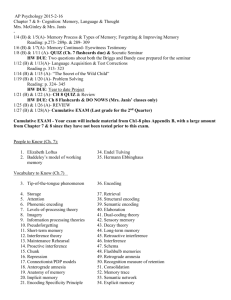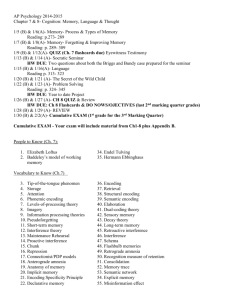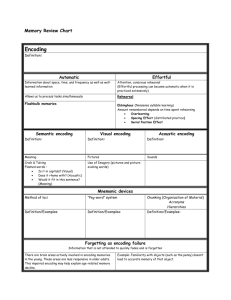KINDS OF LONG-TERM MEMORY
advertisement
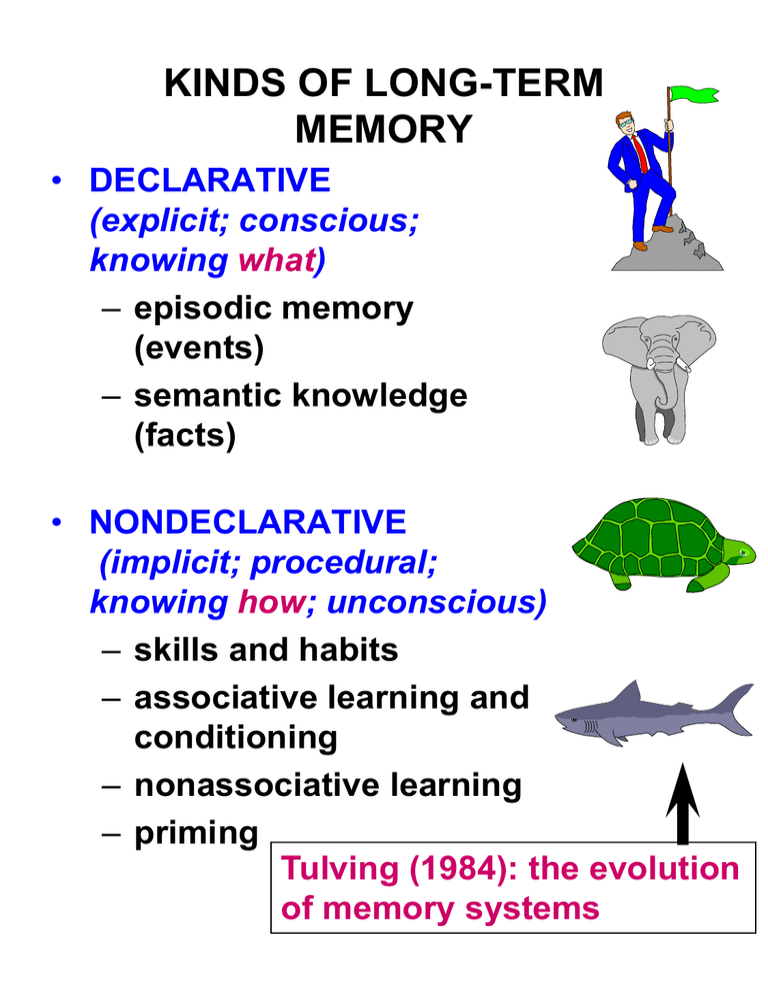
KINDS OF LONG-TERM MEMORY • DECLARATIVE (explicit; conscious; knowing what) – episodic memory (events) – semantic knowledge (facts) • NONDECLARATIVE (implicit; procedural; knowing how; unconscious) – skills and habits – associative learning and conditioning – nonassociative learning – priming Tulving (1984): the evolution of memory systems DISSOCIATING IMPLICIT FROM EXPLICIT MEMORY Implicit Tests (e.g., fragment completion) Explicit Tests (e.g., free recall of words) - profound anterograde amnesia no effect big effect - changing stimulus features between study and test big effect little effect - elaborative encoding during study little effect big effect - time between study and test slow rate of forgetting rapid rate of forgetting PRACTICE AND MEMORY: THE POWER LAW OF STUDY vac, tib, pid, .. dang! • Ebbinghaus (1885) T im e t o R e le a r n – serial learning task – practices lists of 16 nonsense syllables – varies number of study trials – tests himself the next day by “relearning” 25 20 15 10 5 0 1 2 4 8 16 32 Number of Practice Trials 64 MASSED versus SPACED PRACTICE Keppel (1964): study lists of ten paired-associates FLOOR - CARD PEN - TREE etc. # of practice trials on each day in lab: 1st 2nd 3rd 4th massed: --spaced: 2 2 correct in cued recall: immed next week -- 8 95% ___% 2 2 83% ___% “LEVELS OF PROCESSING” AND MEMORY (Craik & Tulving, 1975) question precedes . . . target word decision pos R e c o g n it io n ( % ) sensory level: in capital letters? phonemic level: rhymes with “weight”? semantic level: fits in sentence, “he met a ___ downtown.” neg TABLE fish crate CHAIN FRIEND cloud 100 80 pos target neg target 60 40 Sensory Phonemic Semantic Level of Processing ELABORATIVE ENCODING ADDS RETRIEVAL PATHS irrelevant associations retrieval cue elaboration elaboration target memory elaboration VISUAL IMAGERY AND MEMORY • IMAGERY INSTRUCTIONS AID MEMORY – interactive images: MAN - THUMB • “CONCRETE” WORDS AID MEMORY – DOOR FISH MUG better than NOR WISH SMUG • SUBJECTIVE CLARITY OF IMAGE CAN AID MEMORY – “An old cannon sat on the river bank; a silver coin can be seen . . – %recalled shining on top of it .69 hidden inside the barrel .56 on the ground across the river .55 (Keenan & Moore, 1979) IMAGERY-LINK MNEMONICS Face-Name Associations link the name with a distinctive facial feature ebbing house? New Vocabulary (Sweeny, 1983) SCURRILOUS PEDUNCLE next week: read definition, use in context ___% corr add the “linkword” mnemonic ___% corr USING MNEMONICS IN EVERYDAY TASKS • MNEMONICS WORK BY ENCOURAGING – attention and rehearsal – effective use of prior knowledge – elaborative encoding for distinctive memories • LIMITS TO MNEMONIC TECHNIQUES: – can require extensive training to acquire and effort to use – are often task-specific, and may show litle “transfer” – may become irrelevant as material is practiced A PHENOMENAL MEMORY • Kim Peek, the “Rain Man” – Severely abnormal brain • No corpus callosum • Dwarf cerebellum • Other abnormalities – Astounding memory • • • • • • C. 9,000 books Sports trivia Universal calendar All US zip codes The human mapquest Musical literacy – Astounding encoding • C. 10 sec / page • Two pages concurrently? – Developing new skills • Piano playing and improvisation • Composing?
